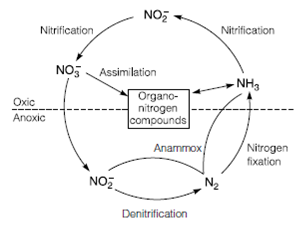Nitrogen cycle
The nitrogen cycle is the easiest to define in terms of the number of participating major nitrogenous compounds. Proteins prosthetic groups such as chlorophyll, nucleic acids and other macromolecules can be regarded as fixed nitrogen present in the marine or terrestrial environments. Ammonia, nitrate and nitrite ions may participate either in the recycling of fixed nitrogen or in the generation of atmospheric molecular nitrogen in Figure. The bulk of molecular nitrogen is reduced through Bacterial nitrogen fixation while very small amounts are reduced through lightning strikes. The biologically mediated processes have been called nitrification, mineralization, denitrification, nitrogen fixation and nitrate reduction.
Mineralization of fixed nitrogen is performed through many microorganisms during the degradation of organic matter and results in the generation of free ammonia. This ammonia may be reassimilated or converted into nitrate by the process known as nitrification. Well-characterized nitrifiers include Nitrosomonas europaea. Nitrification is a two-step process via nitrite.
The conversion of nitrate to molecular nitrogen denitrification is performed through a tax- onomically undefined group of organisms including the Bacteria Paracoccus denitrificans and Pseudomonas aeruginosa as well as the Archaea Haloarcula marismortui and Pyrobaculum aerophilum. Recent evidence suggests which some fungi can also denitrify. Nitrate is converted sequentially into nitrite, nitric oxide and nitrous oxide before nitrogen is released from the organism. Each stage of this process is energetically beneficial to the organism and is generally coupled to the electron transport chain. For this reason it is also called nitrate respiration.
Both Archaea such as Methanosarcina barkeri and Bacteria such as Rhizobium species are also capable of nitrogen fixation or diazotrophy. However, the rhizobia have the unique ability to form nodules on the roots of certain plants allowing nitrogen to be fixed almost directly from atmosphere to plant. The majority of diazotrophs is free living and employs various methods to protect the obligately anaerobic enzyme nitrogenase from the effects of molecular oxygen.

Figure: Nitrogen Cycle